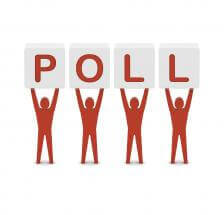How to Use Polling to Keep Your Audience Engaged
Polling is a great way to keep your audience involved. The Public Speaker explains the different ways to take a poll of your listeners.
Lisa B. Marshall
Listen
How to Use Polling to Keep Your Audience Engaged
If I ask you to take a poll, you’ll probably think I work for a political campaign or I’m trying to sell you something. But polling is a great tool for public speakers too. Conducting a poll is an effective way to gather information and involve your audience. >

“What’s this?” she asked the office assistant.
“That’s your clicker. You’ll be using it to answer questions during the presentation.”
That got her attention! She decided that if she was going to be answering questions, she’d better stay alert and even picked a seat closer to the screen.
You see, before the presentation even started, the thought of taking a poll pulled her in. Additionally, she told me that she listened more carefully to each segment of the presentation so she could answer the questions correctly.
She said, “I didn’t want to be that parent who wasn’t paying attention and answered the questions incorrectly!”
Today, we’ll talk about how polling can enhance your presentation and the best ways to do it.
3 Reasons to Take a Poll of Your Audience
Reason #1: To learn more about your listeners
It’s always helpful for you, the speaker, to know some information about who is in the audience – where they come from, if they have attended this event before, what they do for a living, their educational background, etc. Of course, you should learn as much as possible about your audience ahead of time, but often polling just before the presentation is the only way to get key information. By asking the right questions, you can better choose examples and anecdotes to fit the audience. It also works the other way around – to help the audience to understand more about the population of the room.
Reason #2: To create breaks
Let’s face it: our attention spans are not very long. In fact, research indicates the average attention span is getting shorter all the time. One study showed that over the past 10 years our attention spans have dropped from 12 minutes to just 5!
You can use polls to create intentional breaks in your program. The interaction can energize your audience.
Reason #3: To measure or reinforce audience understanding
Polls can also be use to measure or reinforce the understanding of your audience. Unless it’s a classroom, keep the questions basic – it shouldn’t feel like a test. Instead, it’s a barometer that will tell you if you need to cover something in more depth or move on to the next topic.
Also, if you’re unsure of your audience’s prior knowledge of the topic, you can ask basic questions to start a segment. If most people answer correctly, you may not need to spend as much time on that section.
How to Take a Poll
Don’t think that you need some high-tech gizmos to poll your listeners. There are also low-tech options. Let’s talk about how exactly you can poll your audience.
Option #1: Low-tech polling
In most situations, I prefer low-tech polling. I like methods that get my audience moving and allow me to make eye contact with them. Here are some methods I’ve used that work well:
-
Raise Your Hand. We’ve been answering questions by raising our hands since preschool, so we know how to do it. Keep in mind that most people may feel uncomfortable or embarrassed and may not want to raise their hand at first.
-
Stand Up. Ask people to stand up to indicate their answer. For example, “Stand if you have more than 20 years experience in management.” “Great, now please stand if you have more than 10 years experience…” And so forth.
-
Join a Group. Again, you can say something like “If you’re from the West Coast, please move to the back left corner of the room.” I only use this method if I have something to follow up with. Once everyone is in their groups, have them discuss a couple of questions and then report back to the large group with their answers.
-
Rank Yourself. In this case, you are using the walls of the room as a scale. For example, you might say, “If the left wall is 0 and the right wall is 7 and 0 means that you very easily trust strangers and 7 means you have a high distrust of strangers, please stand somewhere between the walls that represents where you fall on that scale.” This one is a bit more complicated to understand by the audience, but can be quite interesting and engaging.
Option #2: Hi-tech polling
However, If you’re looking for a more hi-tech solution for polling your audience, there are many options as well. Let’s look at the 3 main types of polling technology:
-
Clickers. Clickers, or classroom response systems, have been around for many years. The way it works is that students use a clicker to answer a question and their responses are either collected to a server, displayed to the speaker only, or can be shown to everyone on a smart board or screen. The clicker system is expensive and high-maintenance.
-
Audience response applications. These are applications that are built to run in a browser or on a mobile device. Responders use laptops, tablets or smartphones to respond by texting, tweeting, or answering web-based questions. Some of the best known apps are Poll Everywhere, Poll Daddy, and Piazza. You can find a more comprehensive list in the Resources section below.
-
Google Docs forms. This is a low-cost solution to polling, but its use is limited. The speaker can create a Google Doc form and collect answers through the form. Responders would need access to a browser to answer, so this is a better solution for a classroom or workshop setting.
When polling is used thoughtfully, it can help increase participant engagement and deepen learning by providing inormative, instantaneous feedback to the speaker who then can make adjustments that may better address the needs of the audience.
Resources
Alternatives to Clickers in the Classroom (from Princeton University)
Poll and What do you think? images courtesy of Shutterstock.

 Raise Your Hand. We’ve been answering questions by raising our hands since preschool, so we know how to do it. Keep in mind that most people may feel uncomfortable or embarrassed and may not want to raise their hand at first.
Raise Your Hand. We’ve been answering questions by raising our hands since preschool, so we know how to do it. Keep in mind that most people may feel uncomfortable or embarrassed and may not want to raise their hand at first.
